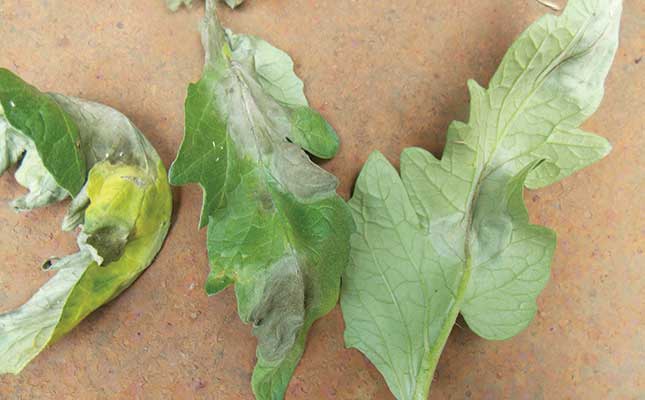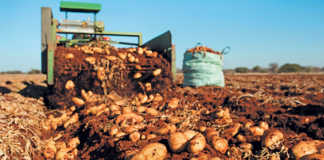
Photo: Bill Kerr
Potatoes originated in South America, which is also the home of the late blight fungus Phytophthora infestans.
The disease attacks potatoes, tomatoes and some other Solenaceous (nightshade family) crops, and was responsible for the Great Irish Famine of the mid-1800s: it destroyed successive potato crops, causing the death of a million people from starvation or hunger-induced illnesses.
Fast-spreading
Late blight spreads so fast that by the time you notice your potatoes are infected, the damage has already been done. When farming in Mpumalanga many years ago, I became aware one season that the conditions were ideal for development of the disease and immediately started to spray my tomato crop as a preventative measure. After a while, however, I ran out of fungicide, so I drove to the local co-op, bought some more, and resumed spraying.
That short delay demonstrated the amazing speed at which late blight spreads; the initial sprayed area ended up being protected, but the area sprayed a few hours later was badly damaged, as the fungus had already taken hold, albeit with no visual evidence at the time. There were no systemic products in those days.
The fungus requires cool, moist weather with eight to 10 hours of surface water on the leaves for the spores to germinate, but I had damage to my tomatoes under plastic cover that year due to a prolonged period of cool weather and rain. There was no way that rain or water could have wet the leaves, but condensation may have formed on the plants overnight.
Resistance
At least 25 wild potato varieties show resistance to P. infestans, and modern varieties have been bred with various degrees of resistance using genes from some of these genotypes.
There are two strains of late blight:
- Type A1 multiplies asexually, so that all the offspring have the identical genetic make-up of the original. This is the strain found in South Africa.
- The A2 mating type can cross with the A1, resulting in offspring with a diversity of genes. This gives the fungus a far greater opportunity to develop resistance to crop chemicals and resistant potato varieties. Genes are exchanged during mating.
Europe had the A1 mating type until 1976, when, during a prolonged drought, traders persuaded the authorities to allow the importation of potatoes from Mexico. Among these was the A2 mating type, which has since made it extremely difficult to keep the fungus under control.
Systemic products
Fortunately, today’s systemic treatments can stop the fungus in its tracks. But all too often, a farmer, out of ignorance or desperation, uses such a product repeatedly and allows the fungus to develop resistance to it and to fungicides with a similar make up.
To prevent this from happening to you, use a product with a prophylactic action, which covers the foliage and prevents the spores from infecting the plant. A systemic product should only be kept for emergency use when the first signs of the disease appear.
As mentioned, when farming, I became very conscious of the climatic conditions that favoured it.
On one occasion, having experienced these conditions, I visited a potato farmer and asked him whether his crop had been infected by late blight. He replied in the negative, but on visiting the lands, we found the odd leaf with symptoms.
Because of this early diagnosis, he was able to spray immediately and prevent the fungus from spreading.
Bill Kerr is a vegetable specialist and breeder.










